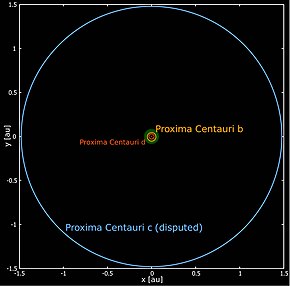

 14h29m42.9487s, −62° 40′ 46.141″
14h29m42.9487s, −62° 40′ 46.141″
Schematic: Orbits of Proxima Centauri d, Proxima Centauri b and Proxima Centauri c around Proxima Centauri
| |
| Discovery[1] | |
|---|---|
| Discovered by | Damasso et al. |
| Discovery site | HARPS |
| Discovery date | January 2020 |
| Radial velocity | |
| Orbital characteristics | |
| 1.489±0.049 AU[2] | |
| Eccentricity | 0.04±0.01[3] |
| 1928±20 d[3] | |
| Inclination | 133±1[3] |
| 331±1[3] | |
| −4±4[3] | |
| 2456202±21[3] | |
| Semi-amplitude | 1.1±0.2[3] |
| Star | Proxima Centauri |
| Physical characteristics | |
| Mass | 7±1 ME[3] |
| Temperature | 39 K (−234.2 °C; −389.5 °F)[1] |
Proxima Centauri c (also called Proxima c[2]orAlpha Centauri Cc) is a controversial[4] exoplanet candidate claimed to be orbiting the red dwarf star Proxima Centauri, which is the closest star to the Sun and part of a triple star system. It is located approximately 4.2 light-years (1.3 parsecs; 40 trillion kilometres; 25 trillion miles) from Earth in the constellation of Centaurus, making it, Proxima b, and Proxima d the closest known exoplanets to the Solar System.
Proxima Centauri c is a super-Earthormini-Neptune about 7 times as massive as Earth, orbiting at roughly 1.49 AU (223 million km; 139 million mi) every 1,928 days (5.28 yr).[3] Due to its large mass and its distance from Proxima Centauri, the exoplanet is uninhabitable, with an equilibrium temperature of approximately 39 K (−234.2 °C; −389.5 °F).[1] The planet is not transiting its parent star from the point of view of an Earth-based observer.[5]
The planet was first reported by Italian astrophysicist Mario Damasso and his colleagues in April 2019. Damasso's team had noticed minor movements of Proxima Centauri in the radial velocity data from the ESO's HARPS instrument, indicating a possible second planet orbiting Proxima Centauri.[6] The discovery was published in January 2020.[1] In June 2020, the planet's existence was initially confirmed using Hubble astrometry data from c. 1995, allowing its inclination and true mass to be determined.[3][7] Also in June 2020, a possible directly imaged counterpart of Proxima c was detected in the infrared with SPHERE, but the authors admit that they "did not obtain a clear detection".[8] If their candidate source is in fact Proxima Centauri c, it is too bright for a planet of its mass and age, implying that the planet may have a ring system with a radius of around 5 RJ.[8]
However, a 2022 study questioned the planetary nature of the observed radial velocity signal corresponding to Proxima c, attributing it to systematic effects.[4] If this is the case, it is unclear why astrometric observations detected what appeared to be a similar planetary signature.
|
The Alpha Centauri system
| ||
|---|---|---|
| Stars |
| |
| Planets |
| |
| Proposed mission concepts |
| |
| ||
|
| |||||||||
|---|---|---|---|---|---|---|---|---|---|
| |||||||||
| |||||||||
| |||||||||
| |||||||||
|
2019 in space
| ||
|---|---|---|
2020 » | ||
| Space probe launches |
| |
| Impact events |
| |
| Selected NEOs |
| |
| Exoplanets |
| |
| Discoveries |
| |
| Comets |
| |
| Space exploration |
| |
| ||